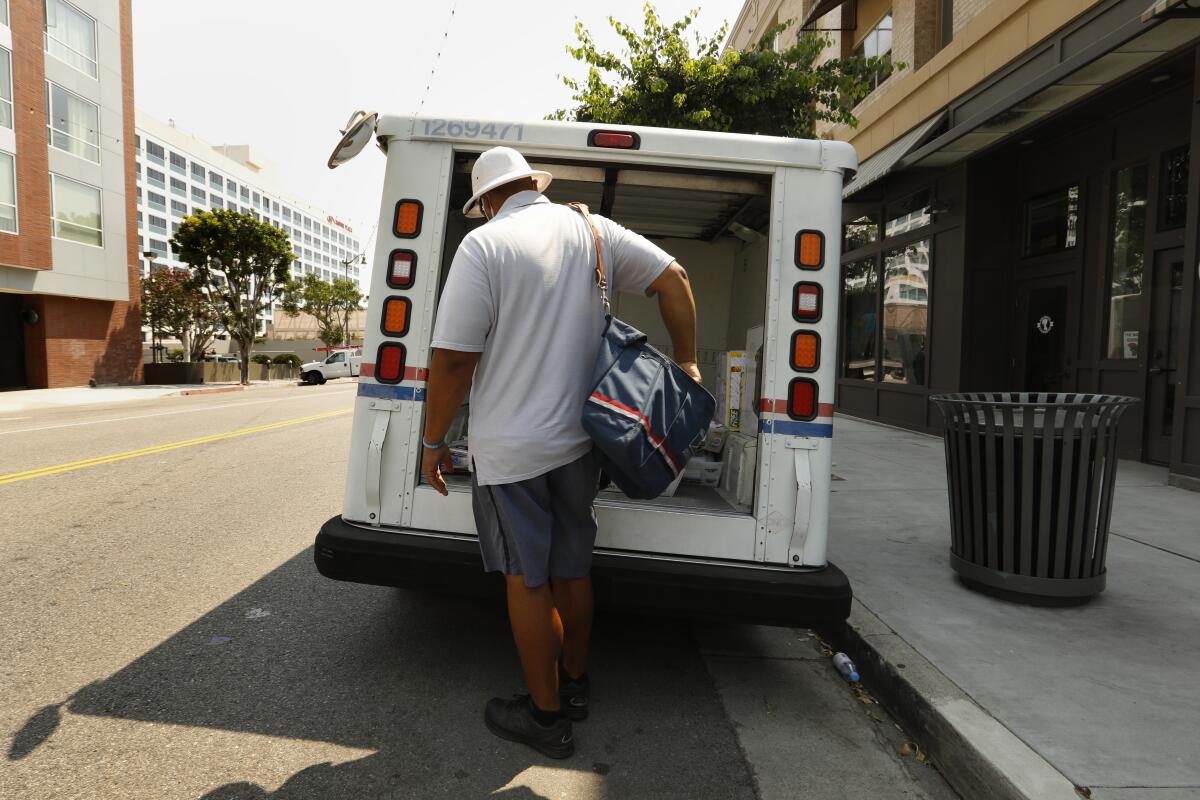Editorial: Cleaner air, arriving soon by U.S. mail

- Share via
It’s the time of year when we see a lot more mail trucks trundling through neighborhoods as letter carriers work hard to deliver everyone’s holiday cards and packages on time.
But this season we have something new to celebrate: The U.S. Postal Service’s announcement this week that it will spend billions of dollars to buy tens of thousands of electric delivery vehicles over the next few years. It’s a victory in the fight against climate change and a welcome shift by an agency that until recently had intended to update its huge, aging fleet with another generation of gas guzzlers. It’s also a win for public health, as a growing number of zero-emission mail trucks will soon start to deliver not only letters and packages, but cleaner air to every corner of the nation.
The Postal Service will buy 106,000 delivery vehicles by 2028, of which 66,000 will be electric, and plans to purchase zero-emission delivery trucks exclusively by 2026. The $9.6-billion plan is a dramatic change from earlier this year, when Postmaster General Louis DeJoy, who was appointed during the Trump administration, planned to make only 10% of the next-generation fleet electric and add as many as 165,000 new gas-guzzling delivery trucks over the next decade that get less than 9 miles per gallon. That would have been a huge mistake considering these vehicles last 30 years and could be on the roads polluting the air and warming the climate into the 2060s.
Don’t fear L.A’s gas appliance ban. The future is electric.
The Biden administration, which does not have direct control over the Postal Service, pushed back nonetheless. California, New York and more than a dozen other states filed suit in April to halt the purchase of gas-powered trucks, joining environmental groups in demanding investments in clean, zero-emission vehicles instead.
California’s intervention “played a big part in stopping USPS from committing to decades of air pollution around the nation,” said Liane Randolph, who chairs the state Air Resources Board.
While the Postal Service will need to do more to fully electrify its aging fleet of more than 220,000 vehicles, this move helps put us closer to achieving President Biden’s climate goals, including an order he issued last year for the federal government to purchase only zero-emission vehicles by 2035, and to do so by 2027 for light-duty vehicles. The nation’s largest vehicle fleet now has the potential to become its largest electric one too. Instead of lagging behind private-sector companies such as Amazon and FedEx, the Postal Service can help lead the way toward a zero-emission future.
As an environmental reporter, I write about how climate change is hurting people and the planet. But at home, I’ve struggled to talk about it with my own daughters.
Mail delivery trucks are especially well-suited for electrification because they run defined, local routes with low daily mileage and have hours of operation that allow them to be easily recharged. Because these vehicles serve virtually every community, electrifying them will bring widespread benefits, curbing air pollution while reducing fuel and maintenance costs and our dependence on oil.
It seems especially significant that something as ordinary and ubiquitous as the white mail truck will now help the nation blaze a trail toward a fossil-free future through every neighborhood in the country. And we won’t have to wait for years either. The new vehicles are expected to go into service on postal routes in late 2023.
That’s a gift we should all welcome this holiday season and enjoy for years to come.
More to Read
A cure for the common opinion
Get thought-provoking perspectives with our weekly newsletter.
You may occasionally receive promotional content from the Los Angeles Times.












